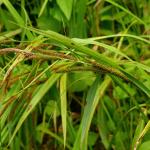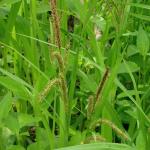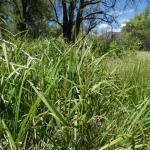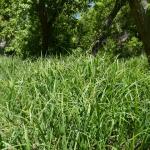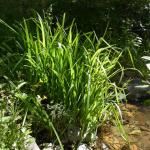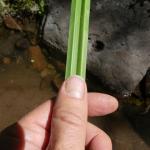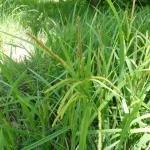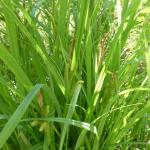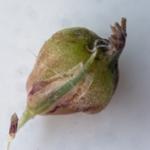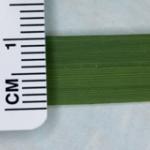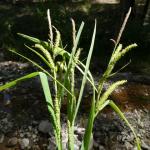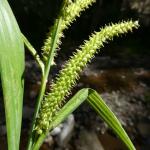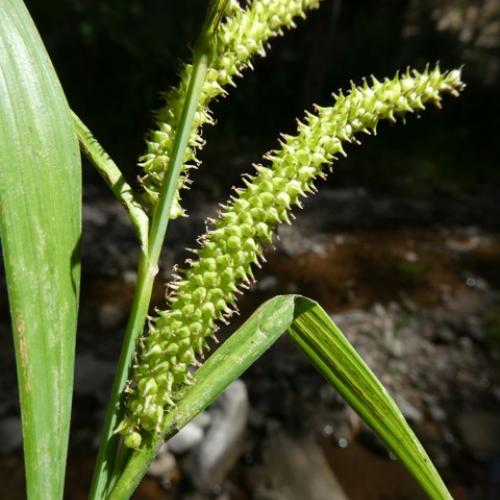Carex amplifolia
None
| USFWS | State of NM | USFS | BLM | Navajo Nation | State Rank | Global Rank | R-E-D Code | NMRPTC Status | Strategy Status |
|---|---|---|---|---|---|---|---|---|---|
| S1 | G4 | SS |
| Documented Threats | Actions Needed |
|---|---|
No Information |
Status surveys on abundance, distribution and threats |
Plants forming large clumps or stands from stout rhizomes; culms 50-90(100) cm tall, shorter to longer than the leaves; leaf blades (5)7-15(20) mm wide, the sheaths pale green to reddish, sometimes red-spotted; inflorescence 15.5-26 cm long, composed of 1-2(3) erect terminal staminate spikes and 3-5(7) ascending to spreading lateral pistillate spikes, the staminate spikes (3)5-8 cm long, the pistillate spikes 3-12 cm long, cylindric, subsessile to pedunculate, the proximal bract leaflike, longer than the inflorescence; pistillate scales shorter and narrower than the perigynia, mucronate to awn-tipped; perigynia 2.4-3.1(3.6) mm long, 1.3-1.7 mm wide, spreading, green to brownish-green, obovoid to subspherical, sub-inflated, with 3-7 strong nerves, abruptly contracted to a minutely bidentate beak, the beak 0.7-1.1 mm long, sometimes bent; stigmas 3; achenes 0.9-1.9 mm long. Flowers May to July.
Carex ultra, Carex senta and Carex utriculata are three other robust Carex with long and narrow pistillate spikes that occur in southern NM. Carex amplifolia is easily distinguished by green perigynia changing to brownish green at maturity with subspherical bodies that abruptly constrict to sometimes bent beaks (0.7-1.1 mm long). Carex ultra has pale green to reddish brown perigynia with red-brown spots and are narrowly obovoid with short, stubby beaks (0.2-0.6 mm). Carex senta has flattened, planoconvex perigynia with short beaks (0.2-0.3 mm). The common wetland sedge Carex utriculata has green to straw-colored to reddish-brown, ovoid to ellipsoid perigynia with prominent beaks that are never bent and often longer (0.8-1.8 mm) than those of C. amplifolia. Carex utriculata perigynia are longer (3-5 mm) with beaks that have prominent teeth (0.2-0.5 mm long) compared to C. amplifolia perigynia (2.4-3.6 mm long) that are minutely bidentate.
New Mexico: Grant, and Sierra counties; known only from several locations in the Black Range and along the Mimbres River. The New Mexico populations represent a major disjunct from more widespread populations in the Pacific Northwest. Carex amplifolia is common west of the Cascades and scattered in mountains and riparian areas as far east as Montana.
Wet meadows on floodplains and streamsides in conifer forests, often in shaded areas; 6100-8800 ft.
Carex amplifolia is an obligate wetland sedge. It is not known how long the New Mexico population has been in the state nor how it became established. Research is needed to analyze for genetic and morphological differences between New Mexico and Pacific Northwest populations of Carex amplifolia.
Current threats to the populations appear to be minimal. The recently discovered populations in Railroad Canyon apparently survived the 2013 Silver Fire. The rhizomatous habit probably protects Carex amplifolia from the drastic effects of most wildfires. Nevertheless, scour and boulder and gravel deposits from potential catastrophic wildfires is a concern. Livestock grazing is another possible threat to populations along the Mimbres River, but the resilient rhizomatous habit of Carex amplifolia probably provides adequate protection. Finally, severe drought caused by climate change could conceivably dry up the streams in the Black Range, thereby extinguishing the associated populations.
Cochrane, T.S. 2002. Carex Linnaeus sect. Anomalae J. Carey, Carices North. U.S., 557. 1847. IN: Flora of North America Vol. 23: Magnoliophyta Commelinidae (in part): Cyperaceae: p. 486-7. Flora of North America Editorial Committee, editors. Oxford University Press: New York.
Hermann, F.J. 1970. Manual of the Carices of the Rocky Mountains and Colorado Basin. USDA Agricultural Handbook No. 374.
Kleinman, R. 2020. Vascular Plants of the Gila Wilderness. Presented in association with the Western New Mexico University Department of Natural Sciences and the Dale A. Zimmerman Herbarium. Carex amplifolia Boott. (Big Leaf Sedge). http://web.wnmu.edu/academic/nspages/gilaflora/carex_amplifolia.html
Licher, M.H., J. McGrath, W.R. Norris, & G.R. Rink. 2020. Carex, p. 69-96. IN: Flora Neomexicana III: An Illustrated Identification Manual, Part 1. lulu.com. In press.
Wilson, B.L., R.E. Brainerd, D. Lytjen, B. Newhouse, & N. Otting. 2014. Field Guide to the Sedges of the Pacific Northwest, second edition. Oregon State University Press, Corvallis, OR.
For distribution maps and more information, visit Natural Heritage New Mexico

